Project Progress – March 2016
Work continues apace on site as we move further into the year when we are due to complete our first project. Elinor provided a detailed report to the General Meeting a few weeks ago, and all is looking good. The foundations for the new build part of the project now support the block walls that level the new with the proginal building – and this work was finished with a week and half in hand. That meant a quieter spell before work began on the timber frame, as contracted, on February 1st.
The ground floor of the frame, beautifully made by Natural Design and Build, is now complete and the upper storey well advanced. The scaffolding buit for this will stay in place for the roofing and external insulation, which we are adopting to maximise space inside the building.
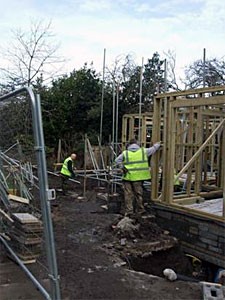
Timber Frame Construction
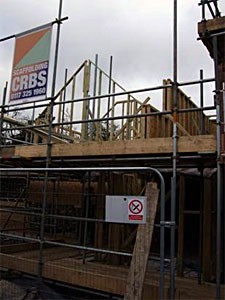
Timber Frame in Progress
Building the frame is a specialist job, but much of the other work on site continues to be done by our volunteers. As well as helping them learn new skills, this keeps costs down – with savings of thousands of pounds to date. That, and other unplanned gains such as the fact that the solar panels on the roof are already generating revenue from the feed-in tariff means the project stands a good chance of coming in under budget.
Behind the scenes there has been a lot of work writing calls for tender and assessing the proposals from potential contractors, as well as continual exchanges with the architects, reconciling details of the plans with the way things actually look on site.
Meanwhile, prospective tenants are shortly to receive a questionnaire, and work is getting under way on outline policies for what will be the tenants’ co-operative once people move in. Suddenly, October doesn’t seem far away.
The mayoral elections are bringing us some attention, with recent site visits from the Green Party candidate Tony Dyer and Bristol University policy researcher (and former councillor) Tessa Coombes. The latter is investigating housing organisations lobbying efforts, and whether the elections for mayor make any difference to those organisations influence. We do hope so.
Project Progress – March 2016
Work continues apace on site as we move further into the year when we are due to complete our first project. Elinor provided a detailed report to the General Meeting a few weeks ago, and all is looking good. The foundations for the new build part of the project now support the block walls that level the new with the original building – and this work was finished with a week and half in hand. That meant a quieter spell before work began on the timber frame, as contracted, on February 1st.
The ground floor of the frame, beautifully made by Natural Design and Build, is now complete and the upper storey well advanced. The scaffolding built for this will stay in place for the roofing and external insulation, which we are adopting to maximise space inside the building.
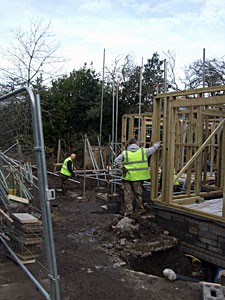
Timber Frame Construction
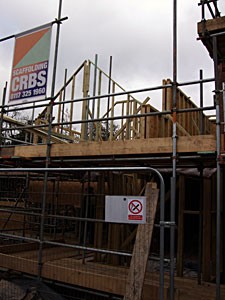
Timber Frame in Progress
Building the frame is a specialist job, but much of the other work on site continues to be done by our volunteers. As well as helping them learn new skills, this keeps costs down – with savings of thousands of pounds to date. That, and other unplanned gains such as the fact that the solar panels on the roof are already generating revenue from the feed-in tariff means the project stands a good chance of coming in under budget.
Behind the scenes there has been a lot of work writing calls for tender and assessing the proposals from potential contractors, as well as continual exchanges with the architects, reconciling details of the plans with the way things actually look on site.
Meanwhile, prospective tenants are shortly to receive a questionnaire, and work is getting under way on outline policies for what will be the tenants’ co-operative once people move in. Suddenly, October doesn’t seem far away.
The mayoral elections are bringing us some attention, with recent site visits from the Green Party candidate Tony Dyer and Bristol University policy researcher (and former councillor) Tessa Coombes. The latter is investigating housing organisations lobbying efforts, and whether the elections for mayor make any difference to those organisations influence. We do hope so.
Waste Management at Battens Lane
Even small DIY jobs seem to end up with loads of rubbish, and my family will tell you how much of a pain I can be about sorting rubbish for recycling. So on site I’ve put a lot of thought into it and am finally getting the system working properly.
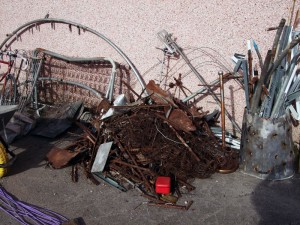
Separated scrap materials.
Scrap metal was easy to dispose of. To deal with the rest I found a skip company with a good system for separating waste so that when we did need to send mixed and construction waste it would be properly processed.
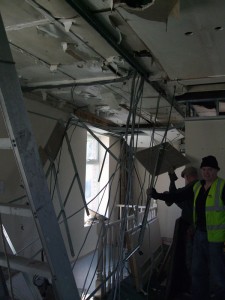
Wires being recovered.
When it came to stripping out the building, we re-used the kitchen in the welfare/break room along with some of the lights, and cleaned up most of the timber to re-use. A lot of wire came out which has been checked and some of it used in the lock-ups, with more available when we do more on them later in the project.
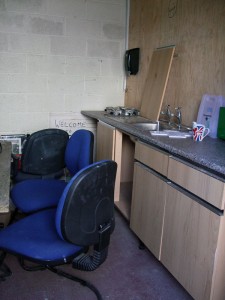
Re-using the kitchen.
There was also a lot of plasterboard to remove, and that has to be separated by law and went with our skip provider. We also took the frame from the suspended ceiling along with the other scrap metal and saved a bit of money.
We have a lot of stone and old bricks which came out when the new door and window openings were made. Some of the stone has been traded with our blockwork subcontractors, Archway, toward some walling work we need later on, and our volunteers have been working hard cleaning up the whole bricks to make them usable for raised beds or perhaps for paving the yard. Most recently the double glazed units from the old windows were advertised via Gumtree and collected by a family using them to build a greenhouse at their allotment.
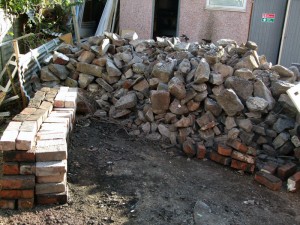
Reclaimed stone and bricks.
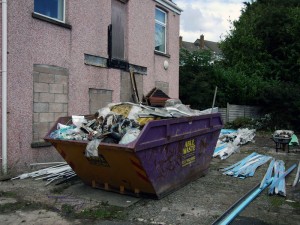
Waste cleared and sorted.
So with enough attention to detail we can dispose of a huge range of stuff usefully. One unsolved problem, though, is the sawdust from the workshop. It is mostly treated timber so can’t be used for animals or compost and I’d rather not just dump it in the skip. I’m hoping one of the local companies which handles scrap wood will let us have a dedicated bin to collect it for them.
It all goes to show that as well as reinventing a building we can re-use a great deal of what comes out of it.
Meeting the Architects
Behind every successful dwelling is an architect – even if the building is converted from an existing one. Our project at Battens Lane is in the hands of Chris Askew and his colleagues, who run a practice in Bristol that specialises in sustainable, community oriented projects.
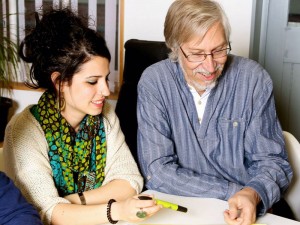
Chris and Nerea in the studio
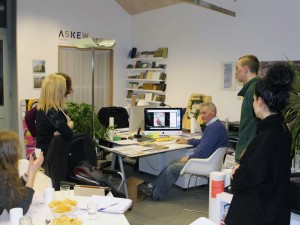
Meeting of prospective residents at
Askew Cavanna studio, looking at finishes
And, crucially, it was mortgageable. That eventually allowed AEOB to secure the loan from Triodos bank that led to the start of building last year. “A twenty-year mortgage is perfectly supportable for us. This is a long-term project, and the figures work.”
With planning and finance in place, the construction has now begun, guided by the detailed plans for, in effect, two buildings – one the conversion of the old structure, one the new, timber-framed extension which will add two flats to the completed complex. The two parts will offer a model of how to refashion an old structure to modern standards, and how to think about organising several dwellings in a single development.
The project architect, Nerea Gonzalez, qualified in Spain, in Pamplona, and came to Bristol to be involved in just such new ways of doing things. After two and a half years, she says, “I feel Bristol still has a lot to teach me about community and social issues. We need this kind of energy and ideas in Spain.”, she says.
Together, she and Askew have worked on details that maximise the benefits of the building and the site. Conforming to the existing plan means the flats are relatively small, so there is much to be gained from space-saving in the detailed design. High-performance, hence low-volume, insulation, under floor heating that obviated the need for radiators, and a common laundry room will all help here. Happily, these options are also in line with other important aims, including low-impact, sustainable construction, and low running costs for the tenants.
Anyone designing buildings for people to live in is looking for a long-lasting result. “People come and go, but the building will stay”, says Askew. At the same time, the prospective tenants who have already come forward are involved in as many design decisions as possible. The day we meet, there is an evening session scheduled where the tenants’ group will inspect samples of floor and wall finishes for all the different rooms – there are a range of tiles and floor coverings fixed to a board to focus the discussion.
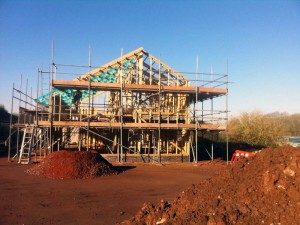
Solarsense Renewable Energy Demonstration Centre –
Being built by Natural Design and Build,
who will be doing the timber frame at Battens Lane
That will mark real progress on the extension. The detail of the larger, old building will be different. “It’s like an old pair of jeans, that’s been patched up over the years”, says Askew. But so far there have been no expensive surprises as the old structure had been stripped out and prepared for the next phase of its life.
“The first place you tend to lose money is underground”, says Askew. With the old structure stripped back, the foundations in place for the extension, and the drains dug, the contractors haven’t uncovered any subterranean problems. Although there is contingency in the budget, things look well advanced to Askew’s experienced eye. It’s a complicated building, but we’re now in a position to tighten up on the cost plan”, he says, which is good news with £100,000 of investment still needed to meet the full development cost before completion in the Autumn.
The whole project exemplifies a feature of architectural practice that must be particularly satisfying. If you really care about things that matter for the future – like affordable housing, using natural materials, energy efficiency and sustainable living, you can actually build things that embody those principles from the foundations to (solar panelled) top.
Work on Site is Moving Ahead Swiftly
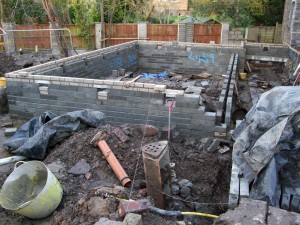
Rising up: Block walls begin to take shape
There was a query about where joists for the new extension would sit which we couldn’t resolve from the plans, so Archway got on with the drains while the architects and structural engineers double-checked everything and clarified exactly what goes where.
This week work on the drains continues, and digging out has now exposed the incoming gas, electric and (shortly) water supplies. We know where they go but will have to put up with them being in the way until the timber skeleton for the new building is there for us to move the main supply anchor points.
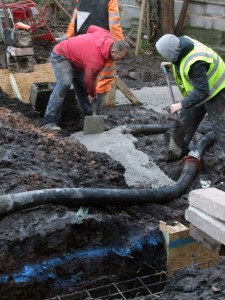
Sound foundations: Pouring concrete
before Christmas
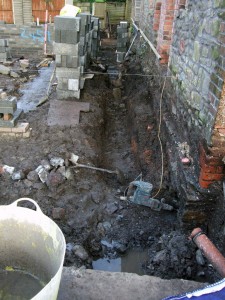
Digging in: A trench for the drains
Away from the site, Site Manager Elinor has tracked down the owner of the building before last occupants, Database, who still operate out of workshops in Kingswood. When they bought the property (From Fussell & Watts, whose details we had found on packing cases) they were given a pack of old deeds, charges, letters and documents dating some as far back as 1920s. These will give an even better picture of the history of the building, and maybe enough clues to look back even further. The rumour we had heard that the buildings were once stables appears to be correct. She is going to contact the local history society to see if anyone knows more or has pictures.
Battens Lane – end of year report
What’s going on at Battens Lane? Shareholder Jon Turney went down to St. George to see.
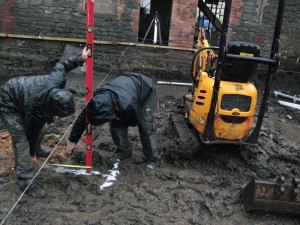
Precision measuring, meet south Bristol clay –
Marking the trenches for the new foundations.
And now we have them! The screw piles we chose were carefully inserted over the last week – they don’t need to sit as deep down as conventional piles, which suits the stiff clay underlying the site and cuts the amount of concrete needed, too. The next stage is to lay the concrete, which will then cure over the Christmas break. That means all is ready to begin building the timber frame for the extension in the new year.
It’s been a foundational year for AEOB in more ways than one. That setting concrete shows how far we’ve come, and confirms the project is on course for tenants to move in next autumn. But that in turn depends on the work achieved in 2015 to move AEOB on financially, legally, architecturally, and in our dealings with the planning system, as well as recruiting site workers and signing up the contractors who you can now see on the front page of the website. There’s the small matter of another £100,00 investment still needed to bridge the gap between what we can draw on from our existing investments and our Triodos mortgage and the projected total cost – but that will need more work next year.
I knew the site was developing fast, but that has kept everyone so busy – in a good way – that regular bulletins on the work in progress have been hard to maintain. So I went down there to see for myself. Here’s what’s going on, by way of an overall update, and as a prelude, I hope, to more frequent reports in 2016.
Elinor Kershaw, now well installed as project and site manager, says happily that the work “is all going reassuringly smoothly: we’re absolutely bang on schedule at the moment”. The day I showed up, extra scaffolding was in evidence, as a prelude to installing additional solar panels on the Southern slope of the roof. Extra lintels to support the panels were already in place. A small digger on the other side of the building indicated where the pile driving was following the outline of the extension.
So there was work in progress at the top and bottom of the building. In between, the shell of the old building (What was it originally? That’s uncertain but it was definitely a plastic film extrusion outfit not that long ago) has been reworked so you can see how the flats inside will take shape.
The old floors and the interior have been stripped out (the pine flooring will be re-used for some of the flats) and door and window openings remodelled. The North facing side of the building was originally stone, contrasting with the unusual triple layers of brick on the other three faces – again we’re not sure why – and is now a pleasing patchwork of old stone and brick. Plans for installing the under floor heating are well advanced, which along with the solar panels will help ensure the flats are cheap to run.
The new year will see a further schedule of new construction, with work starting on the timber frame on Feb 1, on a contract agreed with Natural Design and Build in early December. Then there’s lots more detailed work on the whole building. Drainage on the extended site still needs attention. The under floor pipes will be laid. There are stones and bricks to sort. The outbuildings, one now in use as a well-equipped carpentry workshop, will be remodelled as well. And there are plenty of possibilities to review on energy management, including whether suitable batteries can be installed to make best use of the solar panels, and even whether the currently planned boilers will ultimately be needed.
If that’s not enough, the work to develop the bigger picture that AEOB could be a part of needs to continue in tandem. Visitors come to see how the project was set up – the latest from a Community Land Trust in Lewisham in South London. And Bristol Green Capital promise to help arrange some financial modelling that should help make the case for larger-scale efforts to make better use of empty buildings that could be turned into homes.
The team continue to document how the project has got this far, so what has been learnt can be passed on to people in other cities. Lots of things about the project are locally specific. But Elinor sees lots to pass on from the processes and ways of working that have emerged in Bristol, and from experience here of the kinds of people and organisations to work with the move a project like this from a gleam in the eye to a real effort of brick, stone and concrete. As a (modest) investor, it’s great to see at first hand, and it will be even more exciting to see Battens lane take shape as a dwelling in 2016. Now we need to turn that excitement – and the project deadline – into a boost for raising the remaining capital in the new year, and ensuring the work that has gone so successfully up to now reaches completion on schedule.
AEOB on BBC National TV Primetime’s The One Show
Abolish Empty Office Buildings (AEOB) are creating a new model of charitable and ethical home rental in Bristol by converting unused commercial spaces into genuinely affordable, easy-to-heat, one- and two-bed flats. Our first project in St George, Bristol, attracted the attention of The One Show who spent a day shooting this video which was broadcast on National TV, at primetime.
This is great publicity, and we still are in fund raising mode, needing another £100,000 to complete the building for occupation. Please see our investor information!
Dominic Littlewood the Presenter was great at understanding the issues and challenges facing the AEOB group in carrying out a lot of the preparatory work on the building, and re-using so much of the fabric and contents.
The One Show plan to return as we complete the building, and we can’t wait to show them, and the TV audience, the finished build.
Offices Into Homes – Building a theology of reconciliation
By David Mowat
This is a theological reflection on intertwined stories: an Anglican church icon called a ‘reconciliation reredos’ created for an act of historic healing, a practice of healing through dialogue called a ‘reconciliation laboratory’ and a campaign to solve the housing crisis that came out of the dialogue called ‘AEOB’. Most of the focus is on AEOB, a campaign with a practical method. Along the way is a personal story of a spiritual journey that has included Methodist, Anglican and Quaker approaches.
Why reconciliation?
Reconciliation is not an aspect of Christianity that has resonated with me naturally. I’m much more prone in my life to have believed in God’s ‘bias to the poor’ and was suspicious of ‘reconciliation’ a concept that seemed to me to be about sitting on the fence. To hell with the rich I often thought (guiltily, having had a privileged up-bringing). I worked through these ideas, and my guilt, at the Urban Theology Unit in the early 1980s under the tutelage of Rev Dr John Vincent (one-time President of Methodist Conference). He has since the 1960s kept up core Methodist traditions: anger at social injustice and grass roots-level organisation for social change. He has been a strong influence in my life.
The fate of Dives (Lk 16 v 19-31), tormented for ever in hell because he ignored the Jewish injunction to love neighbour (Lazarus) as himself suggests (I like to think) Jesus may have felt this anger too. The idea of ‘reconciliation’ sticks in my gullet, even now, when I think I see the point of it more clearly. Perhaps I’m writing (does not every act of writing attempt this?) to try and understand what it is and why it matters.
For one thing when Canon Tim Higgins -Franciscan and recent rector of Saint Stephen’s Anglican Church in Bristol- and I sat in the church garden in the late summer of 2010 and talked about what I called a ‘dialogue café’ and he called a ‘reconciliation laboratory’ I felt it was no bad thing to be swayed by the promise of collaborative work, rather than carrying on solo as I was used to.
Secondly, I had felt for a while the inadequacy of one-sided advocacy, be it from a solidarity organisation like the Palestine Solidarity Campaign premised on the unfairness meted out to a nation, the Palestinians, or even the Ecumenical Accompaniment Programme of the World Council of Churches premised on a higher principle of human rights for all. I have served on that programme in Bethlehem. I know the power and the limitation of that ‘accompanier’ identity. I was often struck by the gulf between me and others who happen to be on the other side.
For example once I was simply standing with my EAPPI jacket and note book by a check point whilst a young Israeli woman, doing her military service, was barking at Palestinians and checking their papers through a kiosk intercom. A pretty mundane non-confrontational scene in the scheme of things. When the queue had shifted she asked me with a pained expression “Why are you hurting us?”
Such advocacy (for an end to Occupation in the case of EAPPI) is necessary but it is not sufficient. How could the Israeli soldier and I, and better still the Palestinian caught in the turnstile really hear each other in a way that leads to action and builds to an alternative world? What greater field of knowing is there that sees all and holds all together compassionately? Perhaps the word ‘reconciliation’ expresses this.
After my speaking tour for EAPPI ended in 2009 I wanted to be involved in riskier dialogue than clear advocacy positions allowed, where certainty was suspended and hearts are allowed the space to feel, blindly, as they must. To help Tim by being the facilitator of reconciliation laboratories, what we came to call ‘Rec Labs,’ felt promising, not that I knew what they were.
Tim’s foundation in reconciliation seemed much more assured than mine and so I went with his name for what I felt called to develop. And now I’m exploring this thing called ‘reconciliation’ a little more carefully, not in an abstract way, but through a housing story about what is actually happening and came out of a Rec Lab event.
It is only an artifice that says a story has a beginning and an end. There is actually just a continuous stream of interconnected experience. But intelligibility demands an artifice and I chose to begin with a story of converting an office an office into a community home. Then I take the story back a little in time.
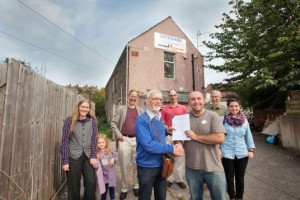 ‘Abolish Empty Office Buildings, House People’ (referred to henceforward as AEOB) is a campaign that has its origins in a ‘Reconciliation Laboratory’ in Saint Stephen’s, a city centre Anglican church in November 2012. You can read about the group and its community share offer on www.aeobhousepeople.org.uk. (Pic shows the AEOB steering group and office owner in Sept 2014 agreeing a purchase of the group’s first property for conversion to an affordable social housing community copy right Mark Simmons).
‘Abolish Empty Office Buildings, House People’ (referred to henceforward as AEOB) is a campaign that has its origins in a ‘Reconciliation Laboratory’ in Saint Stephen’s, a city centre Anglican church in November 2012. You can read about the group and its community share offer on www.aeobhousepeople.org.uk. (Pic shows the AEOB steering group and office owner in Sept 2014 agreeing a purchase of the group’s first property for conversion to an affordable social housing community copy right Mark Simmons).
How does reconciliation work? I think it is through invitation to what sounds like an exciting event, and not through compulsion. It is through exploration of the unknown rather than the following of tested pathways and so it requires risk-taking and the ability to just be ‘all at sea’ (in ‘liminal space’ Tim Higgins calls it). At some point in the exploration it dawns on the person that what is being found feels more important than what is left behind. And ultimately it’s not down to us: something mysterious, call it Grace, call it the Holy Spirit, call it Creativity or whatever you want, is at work.
An invitation: Jesus called the rich man and hated collaborator Zachaeus down from the tree to be his host. (Lk 19 v1-10) Shocked to be snatched from the social margins to the very bosom of community, the giver of hospitality and not just the taker of taxes something in him shifted. He felt released to give half his ill-gotten gains to the poor and pay reparations to the over-taxed.
Two years ago individuals were drawn by a leaflet [below] to the city centre church of Saint Stephen’s. So far their unfolding story, led by the cry ‘Abolish Empty Office Buildings, House People!’ has touched about fifty five people who have released their wealth to purchase shares (about £240,000 to date). AEOB hope that this will release about twelve others from the poverty trap of low income-high rent as they become self-builders and residents of their first converted ex-office, in East Bristol.
Want to help make the city more equal? Whether you think you’re rich or poor, come to the Saint Stephen’s Reconciliation Laboratory and share your story. Out of these hearings we hope a ‘research’ group of rich and poor people, explore together into 2013 how honest face to face meeting leads to personal and city-wide change
“Today salvation has come to this house” says Jesus of Zachaeus. The fruit of a reconciliation is wholeness (‘salve’ can be translated as ‘be whole’) in the body of the community, divided by oppressive practices and hate.
If reconciliation is ‘the activity whereby the disorders of existence are healed, its imbalances redressed, its alienations bridged over’ (Macquarrie, John. Principles of Christian Theology SCM 1977 p 268) then what was true for Zachaeus applies equally to the work of AEOB.
Prophets of old and campaigners new castigate the rich who react by barricading themselves behind ideologies (like neoliberalism) and launch offensives which blame the poor (benefit scroungers, immigrants, yobby activists and so on). Jesus may have been an angry prophet too but was more often an enticer. To be enticed away from your money by a promise of something even more precious, is that not more effective than declaring war on the rich?1
 AEOB have been sending out their invites and offering their shares this past year (and still require more investment to complete the renovation). Their story began in a circle of people meeting in the church café which is a soft foot-fall away from what could be considered a sacred space. Methodists and Quakers may wince at the superstitious notion of sacred space but it’s still strong in Anglicanism. The space lies in front of the ‘Reconciliation Reredos’, a relief frieze, the work of both a Victorian sculptor and of African-Caribbean British artist Graeme Mortimer Evelyn (and Buddhist incidentally) on the wall behind the altar (an angel and Saint Stephen the martyr in this section).
AEOB have been sending out their invites and offering their shares this past year (and still require more investment to complete the renovation). Their story began in a circle of people meeting in the church café which is a soft foot-fall away from what could be considered a sacred space. Methodists and Quakers may wince at the superstitious notion of sacred space but it’s still strong in Anglicanism. The space lies in front of the ‘Reconciliation Reredos’, a relief frieze, the work of both a Victorian sculptor and of African-Caribbean British artist Graeme Mortimer Evelyn (and Buddhist incidentally) on the wall behind the altar (an angel and Saint Stephen the martyr in this section).
The reredos was re-modelled to celebrate the two hundred years since the abolition of the slave trade, at least a step, arguably, towards healing of the social fabric. The significance of the location is that Saint Stephen’s is the historic church by the harbour from which hundreds of slavers left for the triangular trade.
And just as AEOB want to recondition unused dead office buildings into living community, so the unloved and vandalised Victorian reredos2, hidden for years behind a curtain has been transformed into the main icon of Saint Stephen’s Church, fixing gazes towards a deeper understanding of the life and reconciling purpose of Jesus Christ.
Modern Bristol made its wealth through the slave trade horror, setting up unequal relationships in motion that continue to this day. To take one example, plantation owners compensated by the abolition of slavery twenty years on from the end of the trade were able to invest their money in newly developing industry in the city such as the Great Western Cotton Factory in Barton Hill. It paid a pittance to its workers and modelled its working day on the slave plantation system3.
Over the years the rich have stayed rich and the poor stayed poor, including, largely, the slaves’ descendants who came to Bristol as immigrants in the last century. Such structural inequality is exemplified, so the people talking and listening to each other two years ago began to see, in the line that divides house owners from house renters. That’s where AEOB started.
Central to the ‘Reconciliation Reredos’ is the curious carving of a lamb, standing tall as a stallion carrying a cross over its shoulder. The cross, an instrument of torture and symbol of the might of the Roman Empire collides with the victorious lamb, symbol of a tribe and their God in familial closeness, protected from a vengeful angel. In Jesus, a whole system of domination is subverted4. The way of ‘love your enemy’ triumphs over ‘might is right’. But reconciliation is more personal than that: the word means, in English as in the Greek, to ‘make friendly again after an estrangement’ (OED). So the way of Jesus (at least-leave aside the relationship between God and Her/His creation) allows the humanity of all, rich and poor, to be revealed and for friendship to grow.
We were a rum bunch gathering during those three blustery November night ‘laboratories’ two years ago, listening to each other and allowing something beautiful to incubate. A high-born Nigerian refugee turned cleaner and her student daughter attracted by the flyer handed to them on a pavement in Saint Paul’s district, a repentant bijou harbour-side property developer, an ex-traveller, a lonely land-lady dreaming of community and fed up with tenants taking her for a ride, an elderly woman who’d just inherited some money and an ‘involuntary millionaire’ (he told us) who’d made money through three property booms and had recently turned his Clifton mansion into a housing coop. The vision of AEOB came out of these and subsequent gatherings.
How can a vision incubate when differently empowered people gather around such a divisive issue? Drawing principally from the wisdom of silent Quaker meetings for worship and from Scott Peck5-inspired Community Building in Britain, Rec Labs form a circle inviting people to share their story. The emphasis is on listening, on speaking only when moved, on allowing discomfort and silence and mutual responsibility for the unexpected to emerge. It’s a trust-building and creative process and by and large it works. It incubated AEOB.
Away from the safety of the laboratory, does the telling of a powerful story, gentle invitation and deep listening still characterise AEOB and bring reconciliation?
Some people, drawn by the prospect of being a self-build housing coop may not recognise the description of AEOB as an experiment in ‘reconciling’ the rich and poor. Dialectical struggle not dialogue, the exposing of ‘class contradictions’, is a more common approach in activist circles. But in Christian terms, the rich but ‘unclean’tax collector Zachaeus becomes clean (or ‘saved’) through his act of repentance.
Is AEOB likewise an opportunity for restoration by the rich who feel guilty or defiled by their privileges? Arguably so.
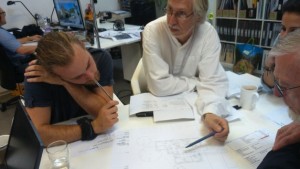 Reconciliation is a revolutionary act. It shortens the distance between people mediated by systems, and so does away with the need for them.
Reconciliation is a revolutionary act. It shortens the distance between people mediated by systems, and so does away with the need for them.
AEOB is, so far, a growing friendly alliance between all kinds of people, citizen-brokers, investors, self-build tenants, supportive professionals amongst others (pic AEOB steering group examining architect Chris Askew’s first plan to convert Battens Road office into flats).
Looking speculatively ahead, were things like AEOB to become multiplied in large scale, bankers would be much diminished in their power and importance and would find again their true purpose, to be of temporary service in providing liquidity. So for instance it seems as if only about 8% of the project funding will come from a bank loan.
What is true for banks is true for all the other professionals we are dealing with, whose mystique diminishes by the day, whose power-over the project reduces as we become more experienced and assertive. We’re beginning to see how the energy that comes from cooperation flows so much more easily than that which comes from compulsion.
And likewise in the New Testament, the Salvation that comes from the life and example of Jesus brings into question the Temple system or the authority of the formally-educated Scribes and Pharisees, let alone the hollow power of Rome. It is no accident that, in its first flush of deep understanding, the early church ‘held all things in common’ and so abolished the divide between rich and poor.
Methodism has long understood what we in AEOB are discovering now. For example ‘several of the Rochdale Pioneers who formed the first Co-operative Wholesale Stores at Toad Lane in 1844 were members of the Rochdale Methodist Unitarian Movement’6.
I yearn for the ‘reconciliation laboratory’ to be a method used in all kinds of conflicts, between Israel and Palestine or between rich and poor to use two examples. We are just at the start of learning how to do this.
– David Mowat Nov 14th 2014.
The writer is an advisor to Abolish Empty Office Buildings which is inviting people to buy shares from £50 to £100,000. Up to date news is on www.facebook.com/AEOBhousepeople and the share offer forms and business plan is on its website www.aeobhousepeople.org.uk. He also has a Diploma in Theology and Mission from the Urban Theology Unit and is currently seeking to develop a ‘reconciliation ministry’ at Saint Stephen’s Church Bristol where he also runs the music programme. www.saint-stephens.com. Contact him on bigbromo@yahoo.co.uk
Footnotes
- The same argument can be developed in the context of Israel and Palestine, but that might be confusing to bring in too many examples. It is only developed here in the context of the social divide between rich property owners with spare investment capital and poor people in insecure rented accommodation.
- I’m indebted to Rev Tim Higgins ‘Reconciliation Reredos’ article June 2013 for understanding its story and theology
- The writer researched the cotton factory some years before for another project. See also https://www.independent.co.uk/…/payouts-after-abolition-8508358.html
- The lamb was sacrificed and the blood smeared on the lintel so that the angel that killed all the first-born sons in Egypt ‘passed over’ (Ex 12:23). In the traditional doctrine of the atonement, Jesus is taken to be the Passover or paschal lamb. This interpretation of the Atonement is developed by Walter Wink as an effective spiritual and social transformation of ‘power as might’ e.g. in ‘The Powers That Be’ Doubleday 1998.
- Scott Peck ‘The Different Drum’ Arrow Books 1990
- From p 12 ANVIL Volume 14 No 11997 Nigel Scotland Methodism and the English Labour Movement 1800-1906
Article From Up Our Street – Spring 2015
Turning Office Buildings Into Homes
Many readers of Up Our Street will be one of thousands of local people living in private rented housing. Sadly some will have a troubling story to tell of poor quality housing, high rents and being left in a vulnerable situation by landlords more interested in profit than providing homes.
Over the past two years a group of people who were concerned about the need for housing and the unfair power relationship between landlords and tenants, got together to see what they could do about it. We met Redfield resident David Mowat, who told us more about Abolish Empty Office Buildings (AEOB) and its plans for the future.
“Our interest is in helping those who are living in vulnerable private rented housing and who want to live in a social housing community. Our model is a cooperative where we raise the money to buy and renovate a property which is then rented out at a fair rate” explains David.
In 2014, AEOB raised the funds to buy a building on Battens Lane in St George. They sold investment shares from £50 or more and secured a loan from Triodos bank. They currently have around £270,000 and need to raise a further £130,000 for refurbishment. “We have an investor who will match £400,000 and the full development will cost about £900,000 so that’s our target. This is an opportunity for anyone with an interest in social justice and some spare cash to contribute to making this project work” says David.
Battens Lane will become six flats with a shared laundry, community room and garages which can be used as creative or workshop space. The concept of living in a cooperative is much more common on the continent and David thinks that we could achieve a lot by creating more of these communities in the UK. “Lots of people have limited resources or need huge mortgages to buy a home.
Our model is about involving the people who will live in the homes in all of the process. If people have skills in building then they can help with construction, in return for reduced rent for the first year, for example. Our thinking is very much about how we can make homes work for people by sharing what we can. We are different from the standard housing association model where the power dynamic remains the same as the private sector and the tenant has to lobby the landlord for anything. Ours is a more equal relationship.”
AEOB also has a clear political position. They are against the continual building of office blocks which remain empty for years when the land could be used for providing much needed housing. “Developers with lots of resources can sit on empty buildings for years, purely to make the highest profit. We feel this is immoral when we have a real need for more affordable housing now” adds David. “We want to raise this higher up the political agenda as well as showing what committed people can do on a small scale.”
Rent from Battens Lane will go into paying off the loan. creating a repair fund and providing a small dividend to shareholders. “I’d say ours is an ‘enlightened’ business model where foremost is people’s need, not the market. We need a shift back to decent renting in this country.”
AEOB is looking for anyone interested in living at Battens Lane and being part of the cooperative. “We want to help those people who have a constant battle with their landlords and are interested in living in a more communal way” says David. They are also keen for more people to invest to make the full vision a reality. “Shares start at £50 and provide an opportunity to use your money for good – providing decent homes for people who need them.”
Article appears on Page 12
Contractors start work on AEOB Battens Lane Affordable Housing
Exciting times on the project – our Community work force have done a great job over the last months, stripped the building and set out the building dimensions with a second hand theodolite off eBay (part of ‘upskilling’ our workforce). They also set up the welfare and storage facilities making use of the old garages on site, all with materials recycled out of the old building. Contractors were selected by a tendering process run by our small team.
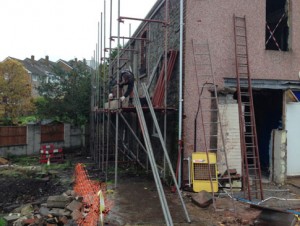
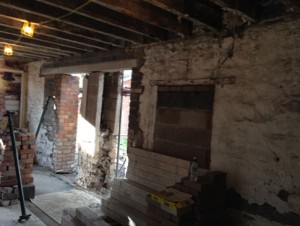
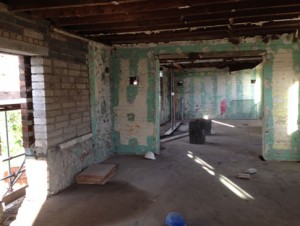
Contractors installed scaffolding on 6th November, and Archway Construction have already made new window and door openings in the thick stone and old brick walls. In the picture, you can see that we re-finished some of the walls with bricks taken from the demolition. These areas will be visible in the final building intentionally showing some of its history.
Our share offer is still open and we need your investment to continue this good work!